
Open Journal of Medical Imaging, 2012, 2, 23-28
http://dx.doi.org/10.4236/ojmi.2012.21004 Published Online March 2012 (http://www.SciRP.org/journal/ojmi)
Computational Fluid Dynamics and Its Impact on Flow
Measurements Using Phase-Contrast MR-Angiograph y
Claus Kiefer*, Frauke Kellner-Weldon
Support Center for Advanced Neuroimaging, Institute of Diagnostic and Interventional Neuroradiology,
University of Bern (Inselspital), Bern, Switzerland
Email: {*claus.kiefer, frauke.kellner-weldon}@csiro.au
Received December 14, 2011; revised December 19, 2011; accepted January 6, 2012
ABSTRACT
Rationale and Objectives: Computational fluid dynamic (CFD) simulations are discussed with respect to their poten-
tial for quality assurance of flow quantification using commercial software for the evaluation of magnetic resonance
phase contrast angiography (PCA) data. Materials and Methods: Magnetic resonance phase contrast angiography data
was evaluated with the Nova software. CFD simulations were performed on that part of the vessel system where the
flow behavior was unexpected or non-reliable. The CFD simulations were performed with in-house written software.
Results: The numerical CFD calculations demonstrated that under reasonable bou ndary co nditions, defined b y the PCA
velocity values, the flow behavior within the critical parts of the vessel system can be correctly reproduced. Conclusion:
CFD simulations are an important ex tension to commercial flow quantification tools with regard to quality assurance.
Keywords: CFD; Flow; Phase Contrast; Angiography; Quality Assurance
1. Introduction
Magnetic resonance phase contrast angiography mean-
while is an established technique to measure the velocity
and the direction of flow [1]. The major drawbacks of
this approach are often related to misaligned encoding
gradients (venc), a too low SNR or high susceptibility
gradients nearby (small) vessels. In each case the relative
phase are not unique and the absolute velocity values are
wrong. At this point the co rrect answer to the flow in the
critical regions can only be derived on the base of physi-
cal models and computational flow dynamics (CFD).
Almost all CFD-problems are associated with the solu-
tion of the Navier-Stokes equations [2,3], named after
Claude-Louis Navier and George Gabriel Stokes, which
describe the motion of fluid substances. The calculations
were performed on incompressible fluids within human
blood vessels. The idea is to selectively model the rele-
vant vessel system and to include the known velocity
values from the PCA measurements within the big ves-
sels as boundary conditions. These velocity conditions
are sufficient in most cases because the velocities tune in
to the given pressure conditions. The intrinsic symmetry
of the vessels furthermore can be used to reduce the di-
mensionality of the problem from three to two, which is
necessary to use the software on commercial computers
with limited working memory and CPU power—on ly the
relative orientation of the v essels and their diameters (e.g.
due to ste noses) have to be consi dered.
The spectrum of potential applications span the simu-
lation of pressure and force distributions near the neck of
aneurysms, the velocity and direction of flow within com-
plex vessel systems with or without stenoses and pres-
sure and vorticity distributions near atherosclerotic pla-
ques.
In this technical note we will concentrate on a few
representative examples in order to demonstrate the im-
portance of quality assurance in addition to commercial
flow evaluation software.
2. Methods
2.1. Flow Measurement
Magnetic resonance phase contrast angiography meas-
urements of flow were performed on a 3 Tesla scanner.
The FLASH sequence parameters were as follows: Base
resolution 256, Phase resolution 60%, Flip angle 25 deg,
TR 113.20 ms, TE 4.66 ms, Voxel size: 0.9 × 0.5 × 4.0
mm, TA: 1:06 min, 1st Signal/Mode Pulse/Retro, calcu-
lated phases 12, segments 5, slices 1. Each slice was
planned on the base of a time-of-flight (TOF) measure-
ment using the Nova software (http://www.vassolinc.com),
which guarantees the exact orthogonal positioning rela-
tive to the course of the vessel. The flow measurements
were performed for a number of selected vessels that
*Correspondi n g a uthor.
C
opyright © 2012 SciRes. OJMI